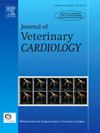使用肋下视图获得猫主动脉频谱多普勒衍生流出速度。
IF 1.3
2区 农林科学
Q2 VETERINARY SCIENCES
引用次数: 0
摘要
简介/目的:在狗和马驹中,肋下(SC)视图获得的频谱多普勒衍生主动脉流出速度(AVs)比左胸骨旁根尖五室(LAp)视图提供更高的值。在猫中,使用SC视图获取AV尚未见报道。本研究的目的是比较SC视图和LAp视图的AV,评估患者和超声心动图变量对差异的影响,并确认在猫中获得SC视图的可行性。作者假设SC视图耐受性良好,并提供更高的av。动物、材料和方法:这是一项前瞻性、单中心、观察性研究,在猫中进行超声心动图检查。进行标准超声心动图研究,包括膝源性房室和可行的SC视图。记录患者的依从性、达到的难易程度和镇静的需要。比较两种视图获得的主动脉流速。确定患者和超声心动图变量对房颤差异的影响。结果:93只猫被纳入研究。由于数据不完整,8只猫被排除在外。最后的分析包括85只猫。大多数猫(81%)容忍SC观点。肋下AVs比LAp速度大0.18 m/s(置信区间±1.25 m/s); p研究局限性:研究局限包括仅涉及单中心、患者耐受性的主观分析、非标准化镇静方案、探针频率和大小,以及少量中度和重度LVOTO、其他心脏疾病或接受治疗的猫。结论:在猫中,SC视图得出的主动脉速度大于LAp视图。SC视图耐受性良好,可以更准确地评估某些猫的LVOTO严重程度。本文章由计算机程序翻译,如有差异,请以英文原文为准。
Use of the subcostal view for obtaining aortic spectral Doppler-derived outflow velocities in cats
Introduction/Objectives
In dogs and foals, spectral Doppler-derived aortic outflow velocities (AVs) obtained from the subcostal (SC) view provide higher values than the left parasternal apical five-chamber (LAp) view. In cats, use of the SC view for obtaining AV has not been reported. The aim of the study was to compare AV from SC and LAp views, assess the impact of patient and echocardiographic variables on the difference and confirm the feasibility of obtaining the SC view in cats. The authors hypothesised that the SC view would be well tolerated and provide higher AV.
Animals, Materials and Methods
This was a prospective, single-centre, observational study in cats referred for echocardiography. Standard echocardiographic studies were performed that included Lap-derived AV and, where feasible, those from the SC view. Patient compliance, ease of attainment and need for sedation were recorded. Aortic velocities obtained from both views were compared. The influences of patient and echocardiographic variables on the differences in AV were determined.
Results
Ninety-three cats were enrolled in the study. Eight cats were excluded due to incomplete data. The final analysis included 85 cats. Most cats (81%) tolerated the SC view. Subcostal AVs were greater than LAp velocities by 0.18 m/s (confidence interval ± 1.25 m/s; P<0.005). Sedation, heart rate, body condition score, bodyweight, aorto-septal angle and left ventricular outflow tract obstruction (LVOTO) did not influence the differences between views.
Study Limitations
The study limitations included involvement of only a single-centre, subjective analysis of patients’ tolerance, non-standardised sedation protocol, probe frequency and size and a small number of cats included with moderate and severe LVOTO, other cardiac conditions, or receiving treatment.
Conclusions
Aortic velocities derived from the SC view were greater than those from the LAp view in cats. The SC view was well tolerated and may offer a more accurate assessment of LVOTO severity in some cats.
求助全文
通过发布文献求助,成功后即可免费获取论文全文。
去求助
来源期刊

Journal of Veterinary Cardiology
VETERINARY SCIENCES-
CiteScore
2.50
自引率
25.00%
发文量
66
审稿时长
154 days
期刊介绍:
The mission of the Journal of Veterinary Cardiology is to publish peer-reviewed reports of the highest quality that promote greater understanding of cardiovascular disease, and enhance the health and well being of animals and humans. The Journal of Veterinary Cardiology publishes original contributions involving research and clinical practice that include prospective and retrospective studies, clinical trials, epidemiology, observational studies, and advances in applied and basic research.
The Journal invites submission of original manuscripts. Specific content areas of interest include heart failure, arrhythmias, congenital heart disease, cardiovascular medicine, surgery, hypertension, health outcomes research, diagnostic imaging, interventional techniques, genetics, molecular cardiology, and cardiovascular pathology, pharmacology, and toxicology.
 求助内容:
求助内容: 应助结果提醒方式:
应助结果提醒方式:


